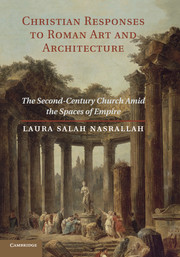 Christian Responses to Roman Art and Architecture
Christian Responses to Roman Art and Architecture Book contents
- Frontmatter
- Contents
- LIST OF FIGURES
- ACKNOWLEDGMENTS
- ABBREVIATIONS
- INTRODUCTION
- PART I FRAMING THE QUESTION, FRAMING THE WORLD
- PART II INTO THE CITIES
- PART III HUMAN BODIES AND THE IMAGE(S) OF GOD(S)
- 5 HOW DO YOU KNOW GOD? ATHENAGORAS ON NAMES AND IMAGES
- 6 WHAT DO WE LEARN WHEN WE LOOK? (PART I) IMAGES, DESIRE, AND TATIAN'S TO THE GREEKS
- 7 WHAT DO WE LEARN WHEN WE LOOK? (PART II) APHRODITE AND CLEMENT OF ALEXANDRIA
- EPILOGUE
- BIBLIOGRAPHY
- INDEX LOCORUM
- INDEX
- References
7 - WHAT DO WE LEARN WHEN WE LOOK? (PART II) APHRODITE AND CLEMENT OF ALEXANDRIA
from PART III - HUMAN BODIES AND THE IMAGE(S) OF GOD(S)
- Frontmatter
- Contents
- LIST OF FIGURES
- ACKNOWLEDGMENTS
- ABBREVIATIONS
- INTRODUCTION
- PART I FRAMING THE QUESTION, FRAMING THE WORLD
- PART II INTO THE CITIES
- PART III HUMAN BODIES AND THE IMAGE(S) OF GOD(S)
- 5 HOW DO YOU KNOW GOD? ATHENAGORAS ON NAMES AND IMAGES
- 6 WHAT DO WE LEARN WHEN WE LOOK? (PART I) IMAGES, DESIRE, AND TATIAN'S TO THE GREEKS
- 7 WHAT DO WE LEARN WHEN WE LOOK? (PART II) APHRODITE AND CLEMENT OF ALEXANDRIA
- EPILOGUE
- BIBLIOGRAPHY
- INDEX LOCORUM
- INDEX
- References
Summary
From the hellenistic period on, praxiteles' sculpture of the Aphrodite of Knidos appears frequently in life-size, over life-size, and miniature reproductions; she is also much discussed in literary sources. She is an object – a sculpture or figurine or painted image – that duplicates and spreads in the Roman Empire. This object, in her many iterations, has complex lives and biographies. The sculpture of the Aphrodite of Knidos inhabits several categories simultaneously, categories one would think to be contradictory: She is a goddess, she is a woman, and she is enslaved in marble or terracotta or stone. She is a goddess whose body is “worn” by Roman matrons commemorated her form, with their own portraits, in funerary statues. She is human in appearance and is a human insofar as she is rumored to have been modeled on Phryne, courtesan lover (hetaira) of the sculptor Praxiteles. What does it mean to duplicate and to trade in such a body or sōma, a term also used in the Roman period for a slave? When we study the proliferation of sculptures in the second century, especially variations on the Aphrodite of Knidos in stone and the many condemnations and celebrations of her in contemporaneous literary texts, what can we make of the exchange value or price of this goddess, or this human, or this object?
- Type
- Chapter
- Information
- Christian Responses to Roman Art and ArchitectureThe Second-Century Church amid the Spaces of Empire, pp. 249 - 295Publisher: Cambridge University PressPrint publication year: 2010


